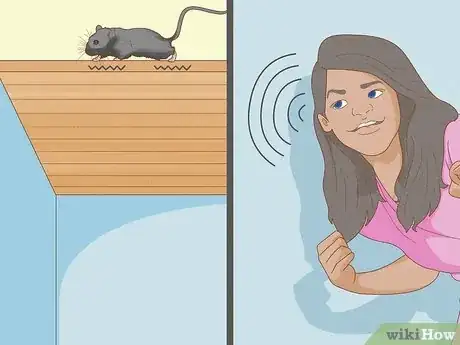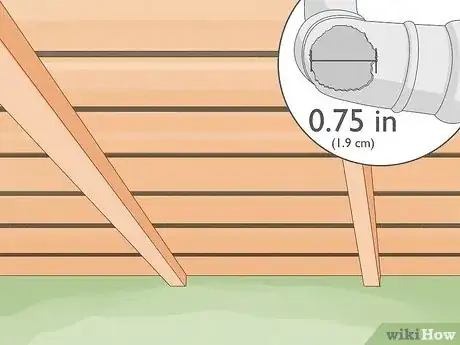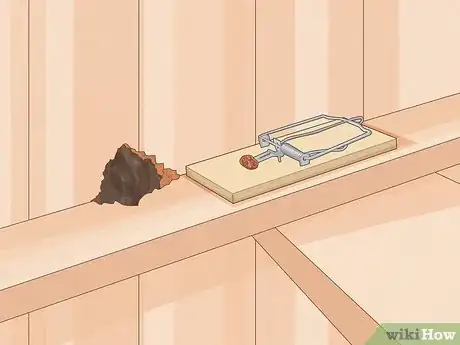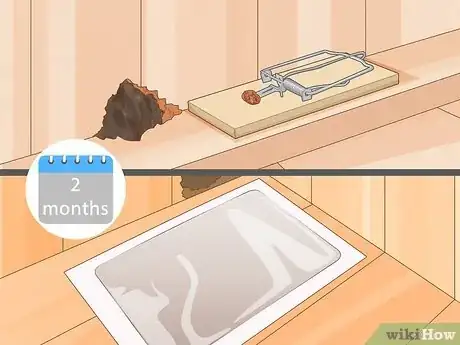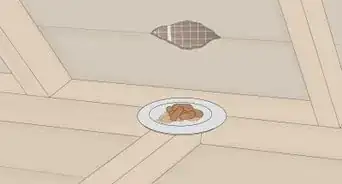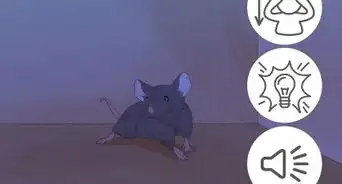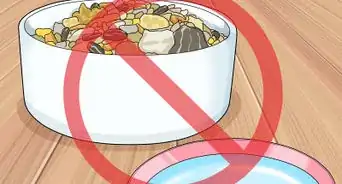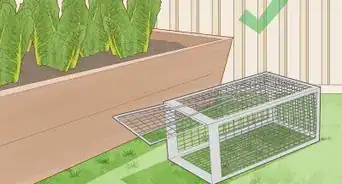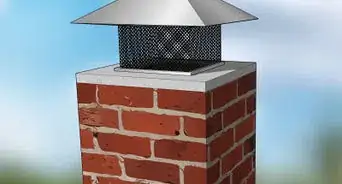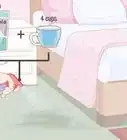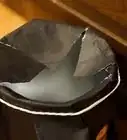This article was co-authored by Chris Parker. Chris Parker is the Founder of Parker Eco Pest Control, a sustainable pest control service in Seattle, Washington. With over seven years of experience, Chris specializes in Integrated Pest Management and doesn’t use any chemicals for pest removal. He offers removal services for ants, rodents, fleas, spiders, wasps, and more. Chris is a certified Commercial Pesticide Applicator in Washington State and received his bachelor’s from the University of Washington.
This article has been viewed 19,050 times.
Roof rats are a very common rat in North America that live in walls, ceilings, and attics. Since roof rats can enter through very small holes in the attic, you can only catch them by sealing off the area where they are living and then trapping them.
Steps
Inspecting for Signs of Roof Rats
-
1Listen for scratching or scurrying in walls and ceilings during the night time. Since the rats are nocturnal, they move around to gather food and make nests at night. Keep an ear to the ceiling or walls to listen for the sound of rats running in the attic.[1]
- This is normally the first noticeable sign of roof rats, and many people can hear the rats without trying to.
-
2Look for smudge marks from oil and dirt along high rafters. Roof rats are climbers, so they normally won’t be leaving normal tracks on the ground. Inspect rafters and higher areas on the walls to look for dark marks left by oils and dirt in their fur.[2]
- Smudges will be most noticeable in high-traffic areas, like rafters that go from one side of the attic to another.
Advertisement -
3Inspect the attic area for droppings along walkways and in corners. Check on rafters and in secluded corners for rat droppings, which are a surefire sign that you have an infestation.[3] They tend to be dark colored, pointed at both ends, and about 0.33 in (0.84 cm) in length.[4]
- You'll likely notice droppings in the attic ceiling and insulation, so be sure to check there.
-
4Look for gnaw marks and tunnels in insulation. In order to build nests and make their home in your attic, the rats will chew or tunnel through anything in their way using their strong teeth and sharp claws.[5] This includes wires, insulation, wood, and even piping.[6]
- Be careful around chewed wires, as they can sometimes still carry electricity. Don’t touch the wires unless you are wearing thick rubber gloves and safety equipment.
Sealing the Attic
-
1Inspect the attic for holes, gaps, and pipes. Use a flashlight to walk around the attic and look for places where the rats might be entering from. Roof rats are excellent climbers and can squeeze through holes as small as 0.75 in (1.9 cm) in diameter.[7]
- If you can’t find anything from the inside, use a ladder to access the roof from the outside. From that perspective, you might be able to see gaps in your roofing or small holes that the rats are squeezing through.
- Keep track of the hole locations by taking pictures and marking them with bright chalk so that you remember where to patch later.
- You can typically tell if these holes are active because you'll see grease marks around them from the oil on the rats' fur, or there may be chew marks where the rats have made the holes bigger.[8]
-
2Cover openings in the attic with metal. Rats can chew through many different materials, but metals like steel are normally too strong for them to break through. Purchase a material like steel flashing or 1⁄4 inch (0.64 cm) mesh, then use bolts to secure the covering over the holes or gaps that you found.[9]
- Make sure that your bolts are tight and secure around the plates to prevent them from coming loose over time.
-
3Seal the repaired areas with caulking to block air flow. Rats can smell outside air coming from small cracks or holes. Once you have the metal plate bolted in place, use caulking applied around the outer edge to stop air and light from entering through tiny cracks.[10]
- Caulking is used to seal windows, so it will hold up against varying temperatures as well as moisture and wind.
- Be sure that all holes are blocked and sealed before and after setting any traps.
Trapping the Rats
-
1Set snap traps to effectively and quickly kill the rats. Place your loaded and baited snap traps along high rafters and in places where you’ve noticed rat activity like chewing or tunneling. When the traps are set, check back every 1-2 days to collect the rats and set new traps.[11]
- Baits like peanut butter, raisins, and nuts are extremely effective for luring roof rats.
- Snap traps are the most effective and easy way to trap and kill roof rats. Poisoning the rats can cause unwanted smells from rats who crawl into inaccessible areas and die.
-
2Place glue boards in the attic as a cheaper alternative to snap traps. Glue boards can be placed in the same areas that you would place snap traps, but tend to be a slightly less expensive alternative. To entice rats, you can place bait on the board like you would for a snap trap.[12]
- Be sure to check glue boards every day, as they will need to be replaced more often than snap traps.
- Sometimes, rats can break free from glue boards by wiggling, or even gnawing off their own limbs. If you notice this is becoming a problem, switch to snap traps.
-
3Monitor the attic for signs of rats for up to 2 months after setting traps. It can take a long time to really get rid of the rats and ensure that they haven't found another place to enter the attic. Be sure to check rafters, insulation, and corners for signs of more rats, even after you feel you've gotten rid of them.
- It might be helpful to keep a few traps set on rafters just in case some rats find a way into the area again. This will keep them from starting nests and deter other rats from entering the attic.
-
4Put mothballs in the attic to repel returning rats. Rats are sensitive to strong smells, and mothballs can be an easy way to scare them off. Set up the mothballs all over the attic, forcing the rats to find a new place to stay.
- This is particularly helpful if you have rats that you can’t get rid of. If they’re coming back, chances are they’ve found another opening. The opening will allow them to escape from the smell and give you time to find and seal it.
-
5Call an exterminator if the rats continue to nest in the attic. As a last resort, contact a local exterminator to inspect the attic. They might be able to better locate where the rats are entering and exiting the attic and give you advice for preventing further infestation.[13]
- Be sure to inform the exterminator of steps that you’ve already taken to trap the rats and seal off the attic.
Expert Q&A
Did you know you can get expert answers for this article?
Unlock expert answers by supporting wikiHow
-
QuestionHow are rats getting onto my roof?
 Chris ParkerChris Parker is the Founder of Parker Eco Pest Control, a sustainable pest control service in Seattle, Washington. With over seven years of experience, Chris specializes in Integrated Pest Management and doesn’t use any chemicals for pest removal. He offers removal services for ants, rodents, fleas, spiders, wasps, and more. Chris is a certified Commercial Pesticide Applicator in Washington State and received his bachelor’s from the University of Washington.
Chris ParkerChris Parker is the Founder of Parker Eco Pest Control, a sustainable pest control service in Seattle, Washington. With over seven years of experience, Chris specializes in Integrated Pest Management and doesn’t use any chemicals for pest removal. He offers removal services for ants, rodents, fleas, spiders, wasps, and more. Chris is a certified Commercial Pesticide Applicator in Washington State and received his bachelor’s from the University of Washington.
Founder, Parker Eco Pest Control If there's anything within 6 feet of your roof, rats can easily jump onto your roof. If there are any tree branches that are going in the area, trim them back. If there are any power lines running to your home, install a baffle, which is like a large plate that goes over the power line so the rats can't jump onto your house.
If there's anything within 6 feet of your roof, rats can easily jump onto your roof. If there are any tree branches that are going in the area, trim them back. If there are any power lines running to your home, install a baffle, which is like a large plate that goes over the power line so the rats can't jump onto your house.
Warnings
- If you use poison to kill rats, it can leave you with the smell of rat carcass throughout your house till you put them away.⧼thumbs_response⧽
- Always wear gloves when transporting rat carcasses. Rats are known to carry diseases in their fur, and saliva.⧼thumbs_response⧽
References
- ↑ https://extension.arizona.edu/sites/extension.arizona.edu/files/pubs/az1280.pdf
- ↑ Chris Parker. Founder, Parker Eco Pest Control. Expert Interview. 15 January 2021.
- ↑ Chris Parker. Founder, Parker Eco Pest Control. Expert Interview. 15 January 2021.
- ↑ http://www.wildlife-removal.com/rats-attic.html
- ↑ Chris Parker. Founder, Parker Eco Pest Control. Expert Interview. 15 January 2021.
- ↑ http://www.wildlife-removal.com/rats-attic.html
- ↑ Chris Parker. Founder, Parker Eco Pest Control. Expert Interview. 15 January 2021.
- ↑ Chris Parker. Founder, Parker Eco Pest Control. Expert Interview. 15 January 2021.
- ↑ http://www.wildlife-removal.com/rats-attic.html
